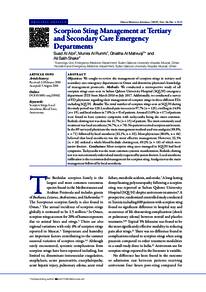Document
Scorpion sting management at tertiary and secondary Care Emergency Departments.
Identifier
DOI 10.5001/omj.2019.02
Contributors
Publisher
Oman Medical Specialty Board.
Gregorian
2019-01
Language
English
English abstract
Objectives: We sought to review the management of scorpion stings in tertiary and
secondary care emergency departments in Oman and determine physician's knowledge
of management protocols. Methods: We conducted a retrospective study of all
scorpion stings cases seen in Sultan Qaboos University Hospital (SQUH) emergency
department (ED) from March 2016 to July 2017. Additionally, we conducted a survey
of ED physicians regarding their management of scorpion stings in three different EDs
including SQUH. Results: The total number of scorpion stings seen at SQUH during
the study period was 128. Localized pain was seen in 97.7% (n = 125), swelling in 14.8%
(n = 19), and local redness in 7.0% (n = 9) of patients. Around 13.0% (n = 17) of patients
were found to have systemic symptoms with tachycardia being the most common.
Bedside clotting test was done for 11.7% (n = 15) of patients. The most commonly used
treatment was local anesthesia (54.7%, n = 70). No patient received scorpion antivenom.
In the 89 surveyed physicians the main management method used was analgesia (88.8%,
n = 71) followed by local anesthesia (81.1%, n = 65). Most physicians (80.0%, n = 64)
believed that local anesthesia was the most effective management. However, 32.5%
(n = 26) ordered a whole blood bedside clotting test, 69.2% (n = 18) of which were
junior doctors. Conclusions: Most scorpion sting cases managed in SQUH had local
symptoms. Tachycardia was the most common systemic manifestation. Bedside clotting
test was not commonly ordered and mainly requested by junior doctors. Local anesthesia
infiltration is the recommended management for scorpion sting. Analgesia was the main
management followed by local anesthesia.
Member of
Resource URL
Citation
Suad Al Abri , Munira Al Rumhi , Ghaitha Al Mahruqi & Ali Salih Shakir. (2019). Scorpion Sting Management at Tertiary and Secondary Care Emergency Departments. Oman Medical Journal, 34(1) , 9-13.
Category
Journal articles

